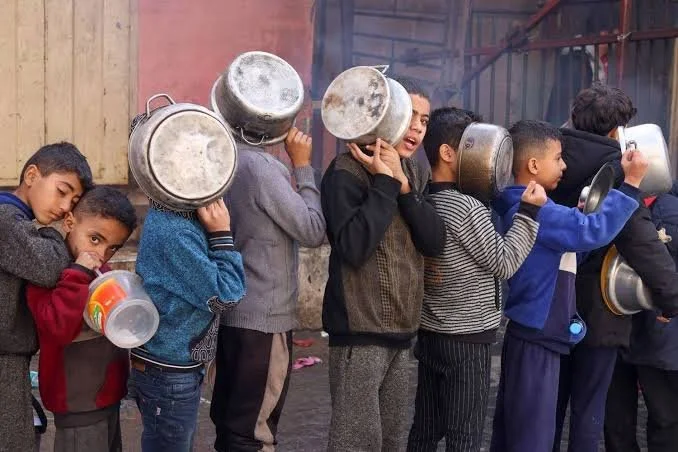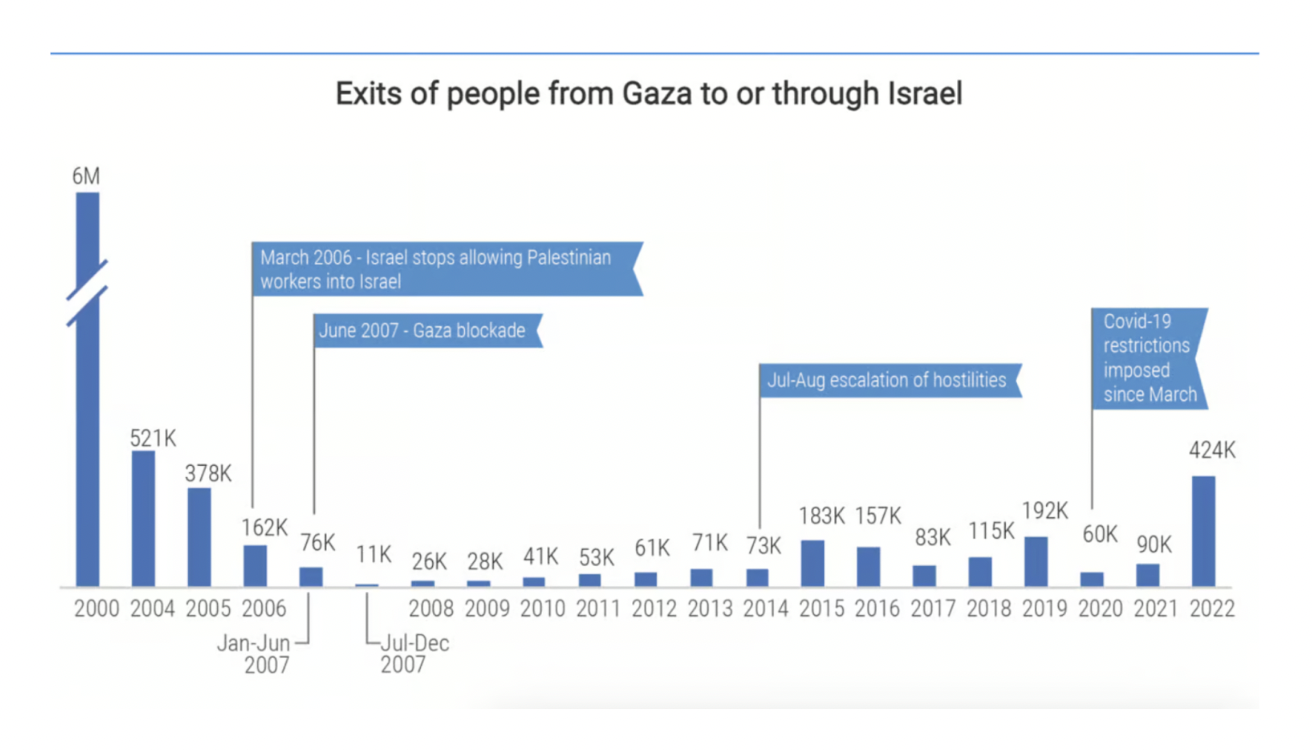A Brief History of Israel’s 33-Year Long Policy of Starving Gaza
Origins of the famine unfolding before our eyes can be traced to January 1991
Hungry children in wait in line for food in Gaza, Palestine. (Photo: EuroMed Monitor)
It’s been 5 weeks since Human Rights Watch reported Israel was starving Palestinians “as a weapon of war;” 5 weeks since the UN said more than 1 in 4 people in Gaza are starving; 5 weeks since 1 in 2 people in Gaza have been facing "Emergency" or "Catastrophe" levels of food insecurity; 5 weeks since the World Health Organizations said the risk of famine is “increasing each day.”
Israel is starving a million plus Palestinians to death. “Everyone in Gaza is hungry,” the UN reported this week. “If the current conditions prevail,” said Alex de Waal, Executive Director of the World Peace Foundation, there would be famine in Gaza by early February.”
According to multiple testimonies (1, 2, 3), people are grinding rabbit fodder into powder to make bread since flour is nowhere to be found. Now, Al Jazeera has reported that even the animal feed has run out. Make no mistake, Gaza is on the brink of famine.
The famine unfolding before our eyes did not begin 5 weeks ago or even 3 and a half months ago.
The origins of the famine in Gaza today can be traced to January 1991, when Israel required all Palestinians in Gaza (and the West Bank) to obtain a permit to enter Israel.
For decades, in the 1970s and 1980s, Israel had incentivized Palestinians in Gaza to work in Israel. The idea was they would earn more money and thus accept the military occupation imposed on them. But, by the late 1980s, the occupation bore resentment. People apparently like to have a say in the government that controls their lives. That was denied to the Palestinians, so they rose up in late 1987 in what became known as The Uprising, or the Intifada.
Israel needed a new strategy to keep Palestinians quiet. Thus was born the work permit regime. All Palestinian in the occupied territories now needed to apply for a permit to work in Israel. A universal right was transformed into a coveted privilege. Israel threatened the livelihoods of 40% of Gaza employed in Israel at the time, and then leveraged the right to work in Israel to subdue Palestinian resistance. Any resistance to the occupation, including non-violent resistance, indeed, any political activity at all, would disqualify Palestinians from receiving work permits.
The work permit regime failed to convince Palestinians to accept subjugation, and so Israel imposed more restrictions, specifically, lockdowns: the Israeli military erected roadblocks and checkpoints in and out of Palestinian towns and villages preventing freedom of movement within Gaza or out of Gaza for periods of 64 days in 1994, 84 days in 1995 and 90 days in 1996. During periods of total lockdowns, unemployment reached a staggering 70% in the Gaza Strip.
This is when food insecurity first reached emergency levels in Gaza. The crisis got so bad that the World Food Programme launched an emergency operation in 1996, targeting 10,000 families in the Gaza Strip struggling to put enough food on the table.
Things improved in the late 1990s, but by the early 2000s, when violence between Israelis and Palestinians reached their highest levels to date, Israel imposed lockdowns again.
With the lockdowns, came mass unemployment, with mass unemployment, came food insecurity. Lockdowns in the early 2000s led to 40% unemployment rates in the Gaza Strip, driving a million Palestinians into food insecurity. A 2004 study found a prevalence of malnutrition and nutrient deficiency in Gaza. The World Food Program launched another “emergency operation” from 2002-4, this time assisting not tens but hundreds of thousands of people in need of emergency food aid.
The situation in Gaza got dramatically worse, and we are still in the early 2000s.
In 2005, Israeli Prime Minister Ariel Sharon decided to tighten the noose around Gaza once again, but he used a clever trick to justify it. He removed Israel’s 6,000 illegal settlers living in Gaza, then declaring “the end of Israeli control over and responsibility for the Gaza Strip.” In Israel’s eyes, whatever happened to Gaza after September 2005 was “not their responsibility.”
International legal experts rejected the argument, because Israel still controlled 6 of the 7 land borders, the population registry, the tax regime, the groundwater, the airspace, the coastal waters, the telecommunication network and the electricity, things that give Israel enormous power over Gaza, things that meant Israel was still the occupying power in Gaza according to most international legal experts.
Then, in January 2006, Hamas won free and fair democratic elections. Six months later, it captured an Israeli soldier, Gilad Shalit. Israel imposed its most severe lockdowns to date, with the Rafah Crossing closed for 148 days in 2006, pushing unemployment rates back over 40%. GDP per capita fell by 30% in a single year.
After Hamas won the 2006 election, the United States and Israel funded and backed Hamas’s rival, Fatah, even though they lost the election. This sparked a civil war, in which Hamas took over Gaza in June 2007.
The Israeli military tightened the noose around Gaza once again to punish the people of Gaza for having elected Hamas. This graph shows the number of exits of people from Gaza from 2000 to 2022:
Within a year, the Palestinian Federation of Industries estimated that 98% of businesses had been forced to shut down. Excluding foreign remittances and food assistance, the poverty rate in Gaza quickly rose to 79%, while 66% were in “deep poverty.”
By the late 2000s, Israel wanted to make the people of Gaza suffer, but not starve. At the time, Israeli leaders didn’t think the world would allow death by actual starvation to happen in Gaza. (Turns out they were wrong about that.)
And so, to ensure no starvation took place, the Israeli Health Ministry began to calculate the caloric needs of the population of Gaza, and allow precisely that much food in. Dov Weisglass, an adviser to former Prime Minister Ehud Olmert, summed up Israel’s policy this way: “The idea is to put the Palestinians on a diet, but not to make them die of hunger.”
By 2023, Gaza’s population had been put on a 16-year “diet”, and was on the brink of collapse. A 2022 UN report found that 76% of households were worried about not having enough food to eat; 54% of Gazans had to borrow money for food; 52% had to reduce expenses on health and 46% had to reduce or cease payment on utilities like electricity to put enough food on the table. Meanwhile, households spent on average 56% of their money on food.
That was the state of Gaza on the eve of October 7th. A besieged population totally dependent on food aid to survive.
After nearly four months of Israel’s genocidal war on Gaza, Israel has imposed its most severe lockdowns to date, preventing any food from entering Gaza for nearly a month, and just a small fraction of Gaza’s food needs since.
At the time of writing, estimates are that 95% of starving people in the world are now in Gaza.
If you enjoyed this article, check out our online courses for a comprehensive understanding of the history of Palestine and Israel.



